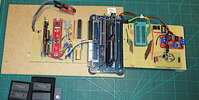Just having a play with some new boards I've had made, currently running a PIC16F18857 and creating a clock, driven by the 32KHz timer1 crystal. The various jumpers allow configuration for a number of purposes, including the 32KHz TMR1 clock, a normal high speed crystal, 12 selectable LED's, and IR remote input and output. The supply voltage can be selected as either 3.3V. 5V. or raw voltage in (such as an 18650).
The LED display is a TM1637 - the colon is flashed in my software, just a 50/50 chance I caught it lit up
![IMG_0969[1].JPG IMG_0969[1].JPG](https://www.electro-tech-online.com/attachments/img_0969-1-jpg.139460/)
The LED display is a TM1637 - the colon is flashed in my software, just a 50/50 chance I caught it lit up

